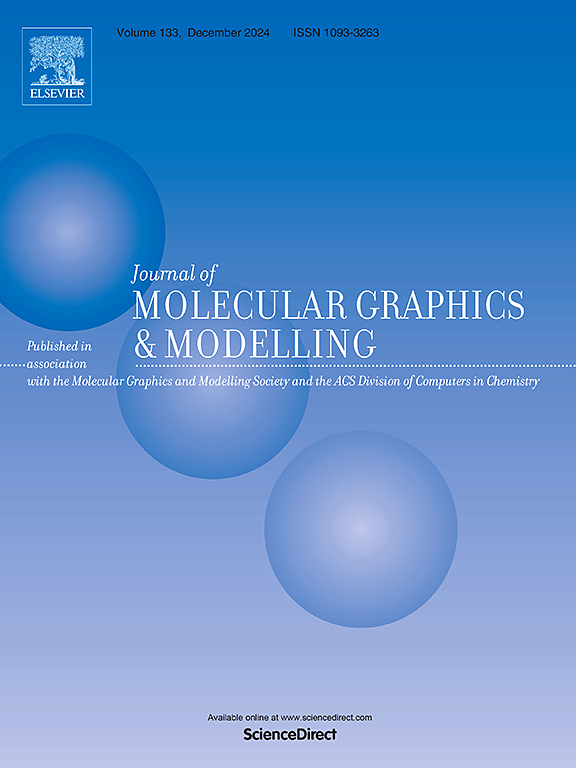Brussonol and komaroviquinone as inhibitors of the SARS-CoV-2 Omicron BA.2 variant spike protein: A molecular docking, molecular dynamics, and quantum biochemistry approach
IF 2.7
4区 生物学
Q2 BIOCHEMICAL RESEARCH METHODS
引用次数: 0
Abstract
Since late 2019, humanity has faced the challenges posed by the COVID-19 pandemic, caused by the SARS-CoV-2 virus. The continuous evolution of SARS-CoV-2 has led to the emergence of multiple Variants of Concern (VOCs) and Variants of Interest (VOIs), posing significant risks to global health. SARS-CoV-2 infects host cells via the angiotensin-converting enzyme 2 (ACE2) receptors, facilitated by the spike (S) protein. Icetexane diterpenes, including brussonol and komaroviquinone, exhibit notable anti-inflammatory, antibacterial, antiviral, antiproliferative, and anticancer properties. Recent research has explored their potential as inhibitors of the SARS-CoV-2 3Clpro protease, showing promising efficacy comparable to Nirmatrelvir. This study investigates brussonol and komaroviquinone as potential inhibitors of the SARS-CoV-2 Omicron BA.2 variant spike protein using molecular docking, molecular dynamics simulations, and quantum biochemistry approaches. The stability and interaction energies of brussonol, komaroviquinone, and mefloquine with the SARS-CoV-2 Omicron BA.2 variant spike protein were evaluated. RMSD analysis demonstrated that komaroviquinone and mefloquine maintain more stable binding poses with the spike protein compared to various NAGs and glycans. Electrostatic potential maps revealed significant interactions with ASN603, a critical residue for ligand binding efficacy. Furthermore, this study addresses a gap in current research, as no studies were found that simulate the trimer of the SARS-CoV-2 BA.2 variant spike protein. Most existing studies focus on the monomer and often exclude the NAGs and glycans. This research underscores the importance of maintaining the NAGs and glycans in the trimer simulations, providing a more accurate representation of the protein's structure and its interactions with ligands. The findings indicate that both komaroviquinone and brussonol exhibit higher binding affinities compared to mefloquine. This study provides valuable insights into the molecular interactions of these compounds, highlighting their potential for further development as antiviral agents against SARS-CoV-2.

Brussonol和komarovi醌作为SARS-CoV-2 Omicron BA.2变异刺突蛋白抑制剂:分子对接、分子动力学和量子生物化学方法
自2019年底以来,人类面临着由SARS-CoV-2病毒引起的COVID-19大流行带来的挑战。SARS-CoV-2的不断演变导致多种关注变体(VOCs)和感兴趣变体(voi)的出现,对全球健康构成重大风险。SARS-CoV-2通过血管紧张素转换酶2 (ACE2)受体感染宿主细胞,由刺突(S)蛋白促进。冰己烷二萜,包括brussonol和komarovi醌,具有显著的抗炎、抗菌、抗病毒、抗增殖和抗癌特性。最近的研究已经探索了它们作为SARS-CoV-2 3Clpro蛋白酶抑制剂的潜力,显示出与Nirmatrelvir相当的有希望的疗效。本研究利用分子对接、分子动力学模拟和量子生物化学方法研究了brussonol和komarovi醌作为SARS-CoV-2 Omicron BA.2变异刺突蛋白的潜在抑制剂。评价了球松醇、科马罗醌和甲氟喹与SARS-CoV-2 Omicron BA.2变异刺突蛋白的稳定性和相互作用能。RMSD分析表明,与各种nag和聚糖相比,科马罗维醌和甲氟喹与刺突蛋白保持更稳定的结合姿态。静电电位图显示了与ASN603的显著相互作用,ASN603是配体结合效率的关键残基。此外,本研究解决了目前研究中的一个空白,即没有发现模拟SARS-CoV-2 BA.2变异刺突蛋白三聚体的研究。现有的研究大多集中在单体上,往往排除了nag和聚糖。这项研究强调了在三聚体模拟中维持nag和聚糖的重要性,为蛋白质的结构及其与配体的相互作用提供了更准确的表征。结果表明,与甲氟喹相比,科马罗醌和球松醇具有更高的结合亲和力。这项研究为这些化合物的分子相互作用提供了有价值的见解,突出了它们作为抗病毒药物进一步开发的潜力。
本文章由计算机程序翻译,如有差异,请以英文原文为准。
求助全文
约1分钟内获得全文
求助全文
来源期刊

Journal of molecular graphics & modelling
生物-计算机:跨学科应用
CiteScore
5.50
自引率
6.90%
发文量
216
审稿时长
35 days
期刊介绍:
The Journal of Molecular Graphics and Modelling is devoted to the publication of papers on the uses of computers in theoretical investigations of molecular structure, function, interaction, and design. The scope of the journal includes all aspects of molecular modeling and computational chemistry, including, for instance, the study of molecular shape and properties, molecular simulations, protein and polymer engineering, drug design, materials design, structure-activity and structure-property relationships, database mining, and compound library design.
As a primary research journal, JMGM seeks to bring new knowledge to the attention of our readers. As such, submissions to the journal need to not only report results, but must draw conclusions and explore implications of the work presented. Authors are strongly encouraged to bear this in mind when preparing manuscripts. Routine applications of standard modelling approaches, providing only very limited new scientific insight, will not meet our criteria for publication. Reproducibility of reported calculations is an important issue. Wherever possible, we urge authors to enhance their papers with Supplementary Data, for example, in QSAR studies machine-readable versions of molecular datasets or in the development of new force-field parameters versions of the topology and force field parameter files. Routine applications of existing methods that do not lead to genuinely new insight will not be considered.
 求助内容:
求助内容: 应助结果提醒方式:
应助结果提醒方式:


